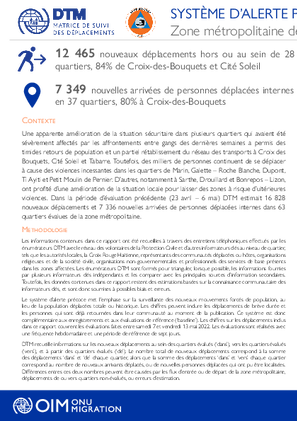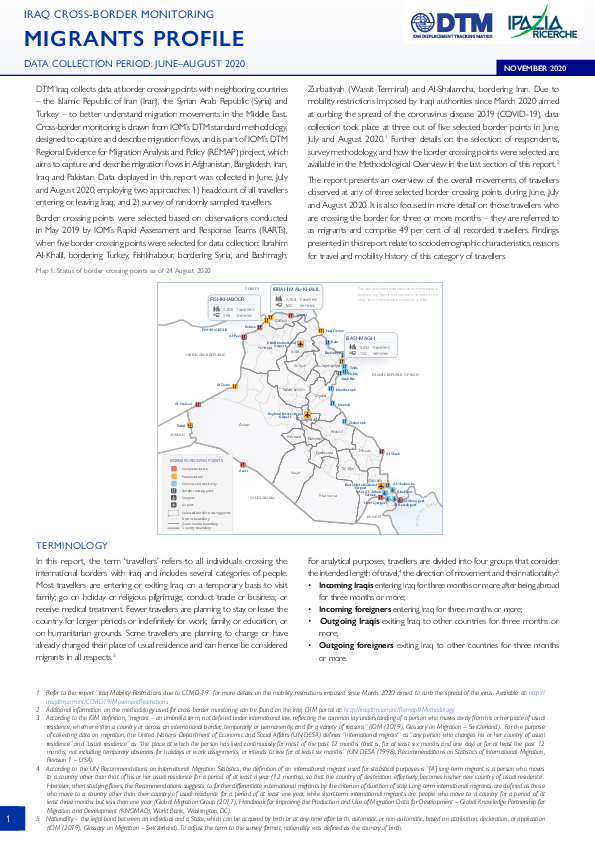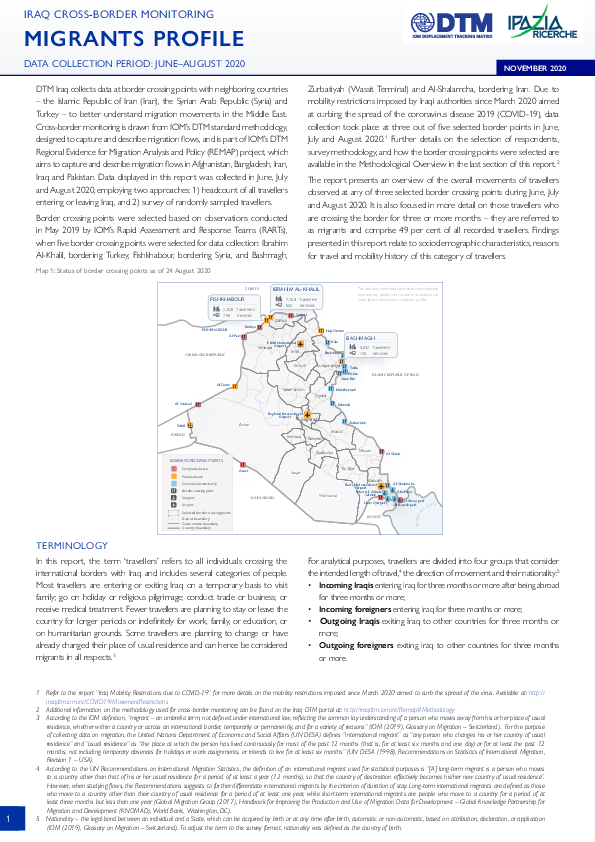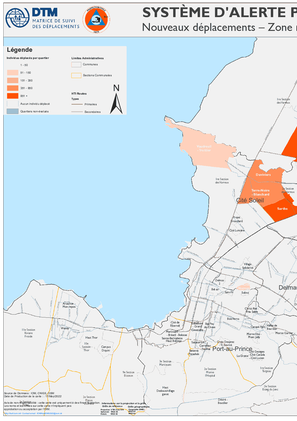-
Countries
-
Data and Analysis
-
Special Focus
-
Crisis Responses

Contact
DTM Iraq, IraqDTM@iom.int
Language
English
Location
Iraq
Period Covered
Aug 01 2020
Aug 31 2020
Activity
- Flow Monitoring Survey
DTM Iraq collects data at border crossing points with neighboring countries – the Islamic Republic of Iran (Iran), the Syrian Arab Republic (Syria) and Turkey – to better understand migration movements in the Middle East.
Cross-border monitoring is drawn from IOM’s DTM standard methodology, designed to capture and describe migration flows and is part of the Regional Evidence for Migration Analysis and Policy (REMAP) project, targeting Afghanistan, Bangladesh, the Islamic Republic of Iran, Iraq and Pakistan.
The report presents an overview of the overall movements of travellers observed at each of three monitored border crossing points during August 2020, their socio-demographic characteristics and reasons for travel. It is also focused on their awareness of COVID-19 symptoms, prevention measures and risk factors.
Système D’alerte Précoce pour les Déplacements - Nouveaux déplacements – Zone métropolitaine de Port-au-Prince – 23 avril au 6 mai 2022
Haiti – Système D’alerte Précoce pour les Déplacements – Nouvelles arrivées de PDI – Zone métropolitaine de Port-au-Prince – 23 avril au 6 mai 2022

Contact
dtmhaiti@iom.int
Language
French
Location
Haiti
Period Covered
May 07 2022
May 13 2022
Activity
- Mobility Tracking
- Event Tracking
Une apparente amélioration de la situation sécuritaire dans plusieurs quartiers qui avaient été sévèrement affectés par les affrontements entre gangs des dernières semaines a permis des timides retours de population et un partiel rétablissement du réseau des transports à Croix des Bouquets, Cité Soleil et Tabarre. Toutefois, des milliers de personnes continuent de se déplacer à cause des violences incessantes dans les quartiers de Marin, Galette – Roche Blanche, Dupont, Ti Ayiti et Petit Moulin de Pernier. D’autres, notamment à Sarthe, Drouillard et Bonrepos – Lizon, ont profité d’une amélioration de la situation locale pour laisser des zones à risque d’ultérieures violences. Dans la période d’évaluation précédente (23 avril – 6 mai) DTM estimait 16 828 nouveaux déplacements et 7 336 nouvelles arrivées de personnes déplacées internes dans 63 quartiers évalues de la zone métropolitaine.

Contact
DTM Mali, DTMMali@iom.int
Language
English
Location
Mali
Period Covered
Apr 01 2022
Apr 30 2022
Activity
- Survey
- Flow Monitoring Survey
- Flow Monitoring
In order to gain a better understanding of mobility flows and trends, the International Organization for Migration (IOM) has implemented the Displacement Tracking Matrix’s Flow Monitoring (FM) tool at key transit points across the region. Flow Monitoring activities are conducted in close cooperation with national and local authorities as well as local partners. The Flow Monitoring tool consists of two main components: the Flow Monitoring Registry (FMR), which captures key data on the volume, origin, destination and mode of travel of mobility flows, and the Flow Monitoring Survey (FMS), individual surveys conducted with travellers to gather detailed information about the profiles, migration experience and intentions of migrants. Through these activities, the Flow Monitoring tool collects data on migration flows and trends, traveller profiles, migration journeys, and intentions of migrants, so as to obtain a better understanding of mobility.
In Mali, DTM conducts Flow Monitoring activities at seven Flow Monitoring Points (FMPs) located across six regions, in order to foster a better understanding of the numbers, trends, profiles, and journeys of migration flows crossing these points.
This reports presents data collected through the Flow Monitoring Registry in April 2022.

Contact
DTM Mali, DTMMali@iom.int
Language
French
Location
Mali
Period Covered
Apr 01 2022
Apr 30 2022
Activity
- Flow Monitoring
Afin de mieux comprendre les mouvements et tendances migratoires, l’OIM, à travers la Matrice de suivi des déplacements (Displacement Tracking Matrix, DTM), met en œuvre l’activité de Suivi des flux de populations (Flow Monitoring, FM).
Le suivi des flux, qui est mis en œuvre en étroite collaboration avec les autorités et des partenaires nationaux et locaux, est composé de deux outils: l’enregistrement des flux (Flow Monitoring Registry, FMR), qui recueille des données clés sur l’ampleur, la provenance, la destination et les modalités des flux de mobilité, et les enquêtes individuelles (Flow Monitoring Survey, FMS), conduites auprès des voyageurs afin d’obtenir des informations sur les profils, parcours migratoires, et intentions des migrants. Le suivi des flux de populations récolte ainsi des données sur les flux et tendances migratoires, les profils des voyageurs et les parcours et intentions des migrants, afin de fournir une meilleure compréhension des mobilités.
Au Mali, la DTM recueille des données au niveau de 7 Points de suivi des flux (Flow Monitoring Points, FMP), répartis dans 6 régions afin d’obtenir une meilleure compréhension de l’ampleur, des tendances, des caractéristiques socio-démographiques et des parcours des flux de voyageurs traversant ces différents points.
Ce rapport présente les données recueillies dans le cadre des activités d’enregistrement des flux durant le mois d'avril 2022.

Contact
DTM Iraq, IraqDTM@iom.int
Language
English
Location
Iraq
Period Covered
Jun 01 2020
Aug 31 2020
Activity
- Flow Monitoring Survey
DTM Iraq collects data at border crossing points with neighboring countries – the Islamic Republic of Iran (Iran), the Syrian Arab Republic (Syria) and Turkey – to better understand migration movements in the Middle East.
Cross-border monitoring is drawn from IOM’s DTM standard methodology, designed to capture and describe migration flows, and is part of IOM’s DTM Regional Evidence for Migration Analysis and Policy (REMAP) project, which aims to capture and describe migration flows in Afghanistan, Bangladesh, Iran, Iraq and Pakistan. Data displayed in this report was collected in June, July and August 2020, employing two approaches: 1) headcount of all travellers entering or leaving Iraq, and 2) survey of randomly sampled travellers.

Contact
DTM Iraq, IraqDTM@iom.int
Language
English
Location
Iraq
Period Covered
Jun 01 2020
Aug 31 2020
Activity
- Flow Monitoring Survey
DTM Iraq collects data at border crossing points with neighboring countries – the Islamic Republic of Iran (Iran), the Syrian Arab Republic (Syria) and Turkey – to better understand migration movements in the Middle East.
Cross-border monitoring is drawn from IOM’s DTM standard methodology, designed to capture and describe migration flows, and is part of IOM’s DTM Regional Evidence for Migration Analysis and Policy (REMAP) project, which aims to capture and describe migration flows in Afghanistan, Bangladesh, Iran, Iraq and Pakistan. Data displayed in this report was collected in June, July and August 2020, employing two approaches: 1) headcount of all travellers entering or leaving Iraq, and 2) survey of randomly sampled travellers.

Contact
DTM Iraq, IraqDTM@iom.int
Language
English
Location
Iraq
Period Covered
Jul 01 2020
Aug 31 2020
Activity
- Survey
- Baseline Assessment
As part of DTM’s migration monitoring activities, the Regional Evidence for Migration Analysis and Policy (REMAP) has been implemented in Iraq since 2019 in response to the critical need to collect and analyze information on displacement and human mobility. The aim of the activity is to strengthen evidence based formulation and implementation of humanitarian and development policy and programming on migration and forced displacement in Afghanistan, Bangladesh, Iran, Iraq and Pakistan.
Following the activities of the REMAP project, DTM collected information on the numbers and locations of mobile population groups, in the current case Iraqis who have moved abroad. This document provides an overview of locations hosting either IDPs or returnees in which Iraqis have departed for another country in the year prior to the assessment, with the intention to emigrate. The data presented in this factsheet is taken from the Integrated Location Assessment (ILA) – Round V (completed from 1 July to 31 August 2020). ILA V provides an in-depth look into the situation of displaced and returning populations across Iraq, with a particular focus on the profiling of the locations in which these groups live. The data collected includes the demographic composition of locations, state of infrastructure, services, security, social cohesion and movement intentions for IDPs, and covers both in-camp and out-of-camp settings.

Contact
DTM Iraq, IraqDTM@iom.int
Language
English
Location
Iraq
Period Covered
May 01 2021
Jul 31 2021
Activity
- Survey
- Baseline Assessment
As part of DTM’s migration monitoring activities, the Regional Evidence for Migration Analysis and Policy (REMAP) project has been implemented in Iraq since 2019 in response to the critical need to collect and analyze information on displacement and human mobility. The aim of the activity is to strengthen evidence-based formulation and implementation of humanitarian and development policy and programming on migration and forced displacement in Afghanistan, Bangladesh, Iran, Iraq and Pakistan.
Following the activities of the REMAP project, DTM collected information on the numbers and locations of mobile population groups, in the current case Iraqis who have moved abroad. This document provides an overview of locations hosting either IDPs or returnees in which Iraqis have departed for another country in the year prior to the assessment, with the intention to emigrate. The data presented in this factsheet is taken from the Integrated Location Assessment (ILA) – Round VI (completed from 1 May – 31 July 2021). ILA VI provides an in-depth look into the situation of displaced and returning populations across Iraq, with a particular focus on the profiling of the locations in which these groups live. The data collected includes the demographic composition of locations, state of infrastructure, services, security, social cohesion and movement intentions for IDPs, and covers both in-camp and out-of-camp settings.

